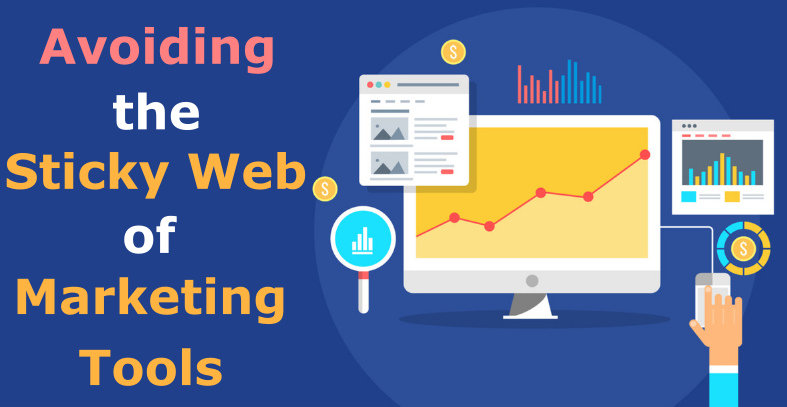Marketing tools are available in mind-blowing numbers. Marketers – amateur and professional – are becoming overwhelmed and very prone to distraction when offered this number of seeming opportunities. However, great numbers do not translate into marketing enrichment, even though many companies own up to using thirty or more ‘unique’ marketing solutions. An organisation may begin with one tool for a single marketing goal, but as these goals increase a new community of tools is added. One example of this unplanned growth in marketing tool implementation is the wide range available for single sources of social media and our need to install them – one for Twitter, one for Facebook, one for Instagram and so on. While a specialist tool may seem the right way to go, those businesses with high online presence soon find that the costs involved – subscriptions, dilution of data and staff training – have the real potential to cancel out any benefits.
In addition, a number of companies allow different departments to have free rein when it comes to choosing marketing tools that suit their needs. While freedom of choice leads to increased creativity, this situation renders that creativity as limited to separate departments. And as already mentioned in the earlier Smarketing blog, the distance between departments blocks company creativity.
Of course, choosing the best tool for each part of each marketing strategy is theoretically a great idea. In practical terms, a disordered mishmash of multiple marketing tools increases costs and spreads data throughout various data silos instead of depositing it into a single, accessible pot. This means that large numbers of marketing tools implemented within a single company lead to three risks that should not be underestimated.
Risk One: Multiple sources of truth
Tools can be so specific they end up providing very different data even when testing for the same marketing purpose. Reactions to your logo on one tool may give you two completely different sets of results. This creates confusion and dilutes the power of further strategies. In this particular case, you might think that multiple tools will eventually give an ‘average’ score – you may think that five tools are better than one, finding a consistent test result represented by every tool rather than a single score from a single tool that may or may not be correct. The advice – use a single, highly recommended tool which is implemented by businesses you know are using the right strategies. While a single subscription to a quality tool might come close to matching the costs of five middle-range tools, concentrating on a single set of quality results will save costs in the long-term and, more importantly, provides a single source of truth.
Risk Two: Incomplete Analyses
When companies give free rein to different departments or even individuals to choose their own marketing tools, that company is guaranteed the huge impracticality of numerous data silos in which incomplete scraps of data are stored. If one department uses a marketing tool to look at purchasing data, only the sales data within that department will be taken into account. In the customer services department, a separate data silo gathers data on customer satisfaction and personal preferences. This means a wide-angle view of the customer journey is therefore impossible and results in an inability to make the most out of sales opportunities. Only with a full 360° view of the customer can one provide powerful marketing strategies that keep them coming back for more.
Risk Three: Inconsistent Customer Experience
When considering risk two, it goes without saying that data silos not only cause inadequate customer analyses but also have the capacity to cause harm within the field of customer experience. Customers are savvy to digital marketing; it doesn’t matter through which channel they arrive at your brand. What does matter is how consistent this contact is – after all, a single brand is a reliable entity they know provides a particular experience. When multiple tools are implemented and each channel uses its own, personalised set, no data is shared. There is no insight into past contact points. Each long-standing customer may be treated like a new one. The movement through the sales funnel is disconnected and uncomfortable.
Sorting Out Your Current Data Ecosystem
To avoid these three risks one should rely on a very small number of user-friendly data systems that everyone within the company can use, analyse and easily interpret the results of. A single solution is obviously ideal, but medium to large concerns would probably need to look into custom data system development.
To make the selection process significantly more straightforward, companies need to do a similarly significant amount of homework, the first step of which is to list every data system your company, each department and each staff member uses. This is often a rather confrontational experience, especially when looking at the sheer numbers of individual choices. Your company data system inventory will more often than not need to be stripped down to a small set of core service that every staff member – after education – can use. When a solution is chosen without considering the further steps mentioned below, the result can provide both an unpleasant working environment and an across-the-board unwillingness to embrace a system that does not cater to everyone’s needs.
The majority of organisations place the CRM at the head of the sales department. This means the sales department has access to the majority of data. However, in any business that provides a service or product, it is the customer who is central. Therefore, the second step in providing an accessible and centralised data system is to map the channels through which your customers come into contact with your brand. This list must also include the times when such interactions take place. A complete inventory of the customer journey, from the first contact through to purchasing and on to feedback and satisfaction is essential; this enables you to shuffle the processes of your data system into the correct and most efficient order.
Once your data systems list and customer journey inventory have been drawn up it is time to study your company’s current data system. With clear information in front of you, this third step is made a simple process of ticks and crosses that show whether your current data system provides for current and future real needs.
1. At which areas are you starting to form distant data silos?
2. Which data is being underutilised?
3. Which tools in your current system provide what you really need?
4. Which tools do you currently lack?
5. How prepared is your current data ecosystem for the future? Is it ready for marketing automation, campaign management, new analytics, e-commerce innovations, AI and machine learning?
Your New Data Ecosystem
Only once you know the requirements of every individual, every department and the company as a whole can you make an educated and unbiased decision regarding your company data system. Merging data rather than filtering it into data silos provides a collaborative environment. Finding a single data system that provides for every need is a long-winded process but well worth the trip. One must also not look at short-term financial aspects but a long-term investment, as the potential savings of stripping multiple subscriptions down to the essential few are often negated by staff training costs. In addition, ironing out the first hiccups of a custom system might cause more distraction and confusion in the first months than bargained for. Yet once this process is complete, every individual within your enterprise has his or her hands on (permitted) essential data and stand-alone analytics. For those unsure of taking any time-consuming step, just ask for a list of the current data system subscriptions your employees use at present. If you are unpleasantly surprised, it is time for a change.


 1300 353 700
1300 353 700 info@magiknewmedia.com.au
info@magiknewmedia.com.au















